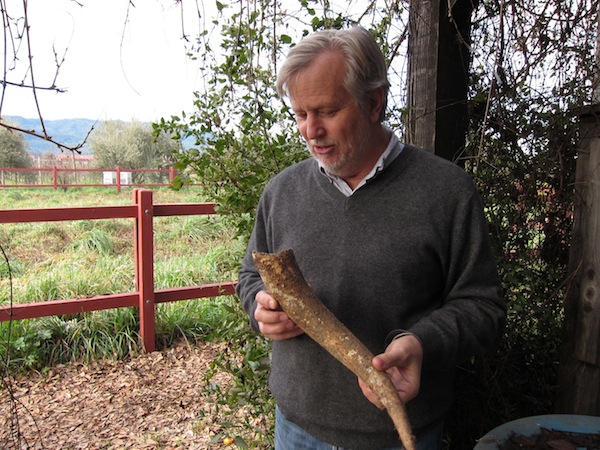San Quirico Vernaccia di San Gimignano and mussels or caraway pork and rye bread stuffing
Vernaccia di San Gimignano grapes
It’s a shame that most visitors to Tuscany, venturing from Florence to the town of Siena, usually miss the pristinely preserved, medieval hilltop town of San Gimignano, a scant 22 miles away. Then again, San Gimignano doesn’t have Brother Moon and Sister Sun as its main attractions; and in fact, its twelfth century church, towers and piazzas hold even more sway than the wine with which the town is associated: Vernaccia di San Gimagnano.
Although Vernaccia di San Gimignano is considered one of Italy’s greatest white wines (given Italy’s highest official classification as a DOCG) – and most certainly, the greatest white wine of Tuscany – it has been all but swept away from the lexicon of American wine drinkers. Partly because it isn’t called “Chardonnay,” and partly because it is, as a matter of fact, very un-Chard-like: lean as opposed to fat, tart as opposed to soft, unfruity as opposed to having “gobs of fruit,” and certainly never richly “oaked.”
Italy's San Gimignano.
But maybe a pure, lean, unfettered dryness is what you like in a wine. If so… wonderful, because the certified organically grown 2006 San Quirico Vernaccia di San Gimignano (about $16) may be everything you want in a wine: a reticent but vividly defined lemon and licorice nose, turning into mineral and anise-like sensations on the palate, packaged in viscous, almost oily, densely textured body that is neither light nor heavy, but rather, zesty (like a fresh, mild grapefruit) yet smooth, long, penetrating.
The other big plus about a classic Vernaccia like San Quirico’s: It is one of the most amazing “food wines” (and I say that as a point of extraordinary quality, rather than relegation) you will ever encounter. It’s not so much its moderation of weight and mouthwatering acidity that make it so, but also its unfruity, licorice-like quality, coupled with a subtle spice that is more like a dried green leafiness, like bay laurel or Thai basil-like, all becoming more pronounced – and fascinating – when matched with white wine friendly dishes prepared with licorice-like herbs like fennel, anise, tarragon, Mexican mint marigold, Thai basils, and to some extent, dill and caraway.
Right away, I think my favorite Louisiana dishes finished with dashes of the anise flavored liqueur, Pernod (oysters Rockefeller and frogs legs); as well as mussels, as it is so commonly served in winy broths laced with fennel or tarragon (re these recipes for mussels with saffron and fennel and mussels in tarragon and shallots). In these food settings, a good Vernaccia di San Gimignano becomes the greatest white wine in the world.
But because Vernaccia di San Gimignano is also a meaty textured dry white, I’ve had even more delicious success with pork dishes cooked with caraway; like this one for Ukrainian roast pork with caraway seeds, or maybe even better, this old Craig Claiborne/New York Times recipe for pork chops with caraway rye bread stuffing. In any case, if you haven’t yet “discovered” this ancient, and extremely food versatile, white wine, now you have something new to look forward to!






Comments
Post a Comment